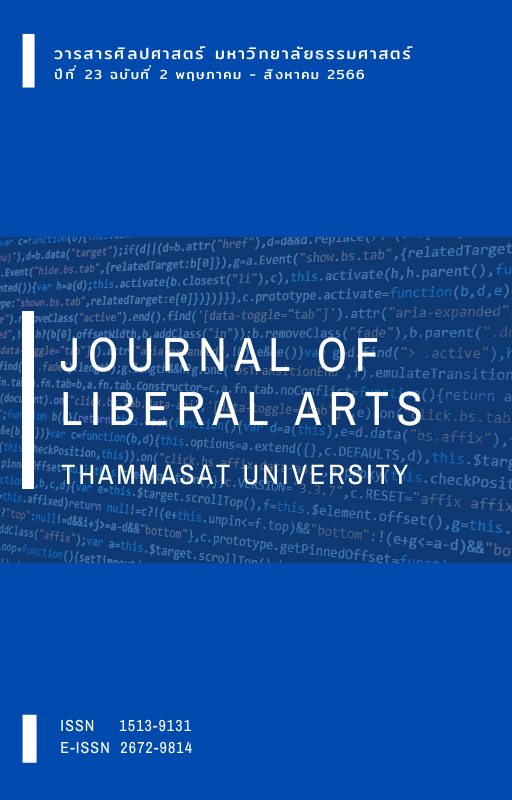อุปลักษณ์มโนทัศน์ของคำว่าใจที่ปรากฏในพุทธศาสนา
Main Article Content
บทคัดย่อ
บทความนี้มีวัตถุประสงค์เพื่อศึกษาอุปลักษณ์มโนทัศน์ของคำว่าใจที่ปรากฏในพุทธศาสนาตามแนวทางภาษาศาสตร์ปริชาน โดยเก็บข้อมูลจากคัมภีร์พระไตรปิฎกแปลไทย ฉบับหลวง พ.ศ. 2514 ประกอบด้วยพระวินัยปิฎก พระสุตตันตปิฎก และพระอภิธรรมปิฎก รวม 45 เล่ม ผลการศึกษาพบว่าสะท้อนอุปลักษณ์มโนทัศน์ได้ 7 อุปลักษณ์มโนทัศน์ดังนี้ [ใจคือวัตถุ] [ใจคือพื้นที่] [ใจคือมนุษย์] [ใจคือธรรมชาติ] [ใจคือสัตว์] [ใจคือไฟ] และ [ใจคืออาหาร] สามารถสะท้อนความคิดและความเชื่อในทางพุทธศาสนาได้ว่าใจไม่เพียงเป็นนามธรรมเท่านั้น แต่ใจยังสะท้อนให้เห็นถึงสิ่งที่เป็นรูปธรรมอีกด้วย
Downloads
Article Details

อนุญาตภายใต้เงื่อนไข Creative Commons Attribution-NonCommercial-NoDerivatives 4.0 International License.
เอกสารอ้างอิง
กรมศาสนา. (2514). พระไตรปิฎกภาษาไทยฉบับหลวง. https://www.thepathofpurity.com/home/พระไตรป-ฎก-pdf/แปล-๔๕-เล-ม-ฉบ-บหลวง/
คยอง อึน ปาร์ค. (2558). มโนทัศน์ของคำว่า ใจ ในภาษาไทยเปรียบเทียบกับภาษาเกาหลี.วารสารศิลปศาสตร์, 15(2), 199-212.
ภัทรา พิเชษฐศิลป์. (2556). มโนทัศน์ของ “XIN” ในภาษาจีนและ “ ใจ” ในภาษาไทยการศึกษาตามแนวอรรถศาสตร์ปริชาน. [วิทยานิพนธ์ปริญญาดุษฎีบัณฑิต, จุฬาลงกรณ์มหาวิทยาลัย]. Chulalongkorn University Intellectual Repository.
ราชบัณฑิตยสถาน. (2554). พจนานุกรมฉบับราชบัณฑิตสถาน พ.ศ. 2554. http://www.royin.go.th/dictionary/
สนิท ศรีสำแดง. (2544). ปรัชญาเถรวาท. โรงพิมพ์แห่งมหาจุฬาลงกรณราชวิทยาลัย.
สุกัญญา รุ่งแจ้ง. (2548). อุปลักษณ์เชิงมโนทัศน์ของการใช้คำว่า “ใจ” ในภาษาไทย. [วิทยานิพนธ์ปริญญามหาบัณฑิต, มหาวิทยาลัยธรรมศาสตร์]. Thammasat University Digital Collections.
Evans, V. (2004). The structure of time: Language, meaning and temporal cognition. John Benjamins.
Evans, V. (2007). A glossary of cognitive linguistics. Edinburgh University Press.
Evans, V., & Green, M. (2006). Cognitive linguistics: An introduction. Edinburgh University Press.
Gibbs, R. (1994). The poetics of minds: Figurative thought, language, and understanding. Cambridge University Press.
Johnson, M. (1987). The body in the mind: The bodily basis of meaning, imagination, and reason. Chicago University Press.
Kövecses, Z. (2002). Metaphor: A practical introduction. Oxford University Press.
Kövecses, Z. (2010). Metaphor: A practical introduction (2nd ed.). Oxford University Press.
Lakoff, G., & Johnson, M. (1980). Metaphors we live by. The University of Chicago Press.
Pragglejaz, G. (2007). MIP: A method for identifying metaphorically used words in discourse. Metaphor and symbol, 22(1), 1-39.
Sharifian, F. (2008). Conceptualizations of del ‘heart-stomach’ in Persian. In F. Sharifian, R. Dirven, N. Yu, & S. Niemeier (Eds.), Body, Culture, and Language: Conceptualisations of heart and other internal body organs across languages and cultures (pp. 247-265). Mouton de Gruyter.
Yu, N. (2009). The Chinese heart in a cognitive perspective: Culture, body and language. Mouton de Gruyter.


